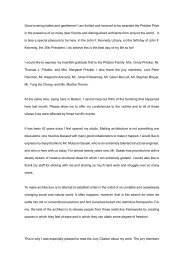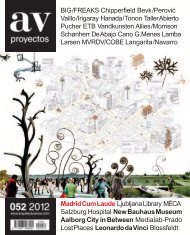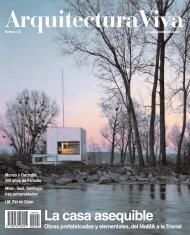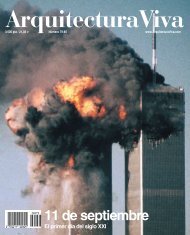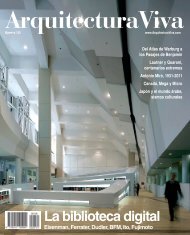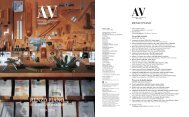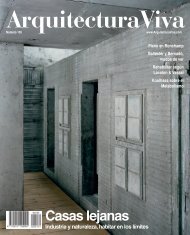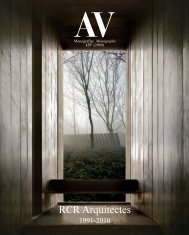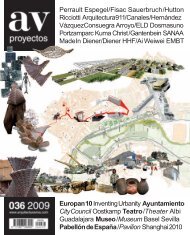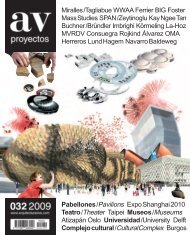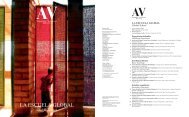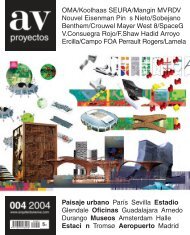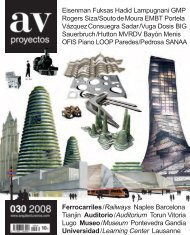FRANCISCO MANGADO - Arquitectura Viva
FRANCISCO MANGADO - Arquitectura Viva
FRANCISCO MANGADO - Arquitectura Viva
Create successful ePaper yourself
Turn your PDF publications into a flip-book with our unique Google optimized e-Paper software.
Decálogo didáctico<br />
De forma casi inadvertida, los jóvenes turcos devienen jóvenes maestros.<br />
Doblado el cabo de los 50 años, y con 25 de ejercicio profesional, Francisco<br />
Mangado no es ya el representante arquetípico de aquella joven generación<br />
española que ingresó en las escuelas de arquitectura al mismo tiempo que se<br />
alumbraba la democracia, y que inició su vida profesional coincidiendo con las<br />
ilusiones políticas de los primeros gobiernos socialistas y con la prosperidad<br />
económica de la segunda mitad de los años ochenta. Esa generación pragmática<br />
y plural, «sin otra adscripción definida que a una cierta abstracción lírica ni<br />
otra fidelidad notoria que a un impreciso realismo constructivo», como en su<br />
momento la describí, ha conocido la decepción política y la crisis económica,<br />
fragmentándose en un haz de trayectorias individuales donde la de Mangado es<br />
una de las más destacadas, probablemente la más prolífica, y sin duda alguna<br />
la más enérgica en su activismo pedagógico.<br />
Convertido en un maestro constructor que ha dejado ya su impronta en un<br />
sinnúmero de promociones de la Universidad de Navarra —compartiendo la<br />
vocación docente de buena parte de sus coetáneos, pero también en la tradición<br />
académica de sus paisanos Francisco Javier Sáenz de Oíza, que marcó con su<br />
enseñanza oracular la Escuela de Madrid, o Rafael Moneo, que transformó con<br />
su erudición inteligente Barcelona primero y Harvard después—, Mangado ha<br />
concebido su formidable acervo de obras en diálogo permanente con una inquietud<br />
social y política que le mueve a perseguir una disciplinada responsabilidad<br />
contextual, técnica y económica más bien que a delinear una carrera basada<br />
en la autoría y el lenguaje. Es esta voluntad de ejemplaridad pedagógica<br />
—que con todo no excluye que la consistencia de su trayecto lo vaya haciendo<br />
autor malgré soi— lo que ha animado a publicar diez obras de su última década<br />
bajo la asignación a un decálogo personal.<br />
Presentados con su prosa urgente, y en orden cronológico de proyecto, en el<br />
número se suceden la sabiduría urbana y contextual del Baluarte, el material<br />
táctil en el bronce del museo arqueológico de Vitoria, la topografía granítica e<br />
histórica del palacio de congresos de Ávila, la economía exacta de la sede de<br />
Gamesa Eólica, la exploración técnica del centro de formación de Santiago, el<br />
alarde espacial del auditorio de Teulada, el programa heterogéneo del estadio<br />
de Palencia, la fertilidad creativa del proceso en la piscina de Orense, el impacto<br />
simbólico de la representación en el Pabellón de España y el respeto a la<br />
naturaleza y el medio rural en los galpones lacónicos de la hípica de Ultzama:<br />
una obra horaciana con la que el arquitecto y aquí también cliente cierra el bucle<br />
navarro, regresando a los paisajes esenciales de su origen, donde inició su camino<br />
con plazas o bodegas y donde todavía encuentran alimento las robustas<br />
convicciones de este reformador à rebours.<br />
Luis Fernández-Galiano<br />
Almost inadvertently, young Turks become young<br />
masters. Just after turning 50, and after 25 years of<br />
professional activity, Francisco Mangado is no longer<br />
the archetypal representative of that young Spanish<br />
generation that entered the schools of architecture<br />
during the initial years of democracy, and that started<br />
professional life coinciding with the political hopes<br />
sparked by the first socialist governments and with the<br />
economic prosperity of the second half of the eighties.<br />
This pragmatic and plural generation, “committed<br />
only to a certain lyrical abstraction and with no other<br />
obvious fidelity than to a vague constructive realism”,<br />
as I once described it, has experienced both political<br />
disappointment and economic crisis, breaking up into<br />
a spreading bundle of individual trajectories where<br />
that of Mangado is one of the most prominent, probably<br />
the most prolific, and without a doubt the most forceful<br />
in its pedagogical activism.<br />
Already a master builder who has left his mark on<br />
countless classes of the University of Navarre – sharing<br />
the didactic calling of many of his contemporaries, but<br />
also in the academic tradition of two great architects<br />
from the same region, Francisco Javier Sáenz de Oíza,<br />
whose oracular teachings were a strong influence in<br />
Madrid’s School of Architecture, or Rafael Moneo, who<br />
transformed with his intelligent learning Barcelona first<br />
and Harvard afterwards –, Mangado has conceived his<br />
long list of built works in permanent dialogue with a<br />
social and political drive which moves him to exercise<br />
a contextual, technical and economic responsability<br />
rather than pursue a career based on authorship and<br />
language. This demanding quest for didactic discipline<br />
– which does not exclude that his consistent course is<br />
turning him into an author malgré soi – has encouraged<br />
us to publish ten works of his last decade arranged<br />
under a personal decalogue.<br />
Presented with his urgent prose, and in chronological<br />
order of project, the issue threads the contextual and<br />
urban wisdom of the Baluarte, the materiality of bronze<br />
in the archaeological museum of Vitoria, the granitic<br />
and historical topography of the Ávila congress center,<br />
the exact economy of the Gamesa Eólica headquarters,<br />
the technical search in the training center of Santiago,<br />
the spatial display in Teulada’s auditorium, the mixed<br />
program in Palencia’s stadium, the fertile creativity<br />
of the design process in the swimming pool of Orense,<br />
the symbolic impact of representation in the Spanish<br />
Pavilion and the respect for nature and the rural context<br />
in the laconic sheds of the equestrian center of Ultzama:<br />
a Horatian work with which the architect and here also<br />
client closes the Navarre circle, returning to the essential<br />
landscapes of his origin, where he began his journey<br />
with small squares or wineries and where the strong<br />
beliefs of this reformer à rebours still find nourishment.<br />
AV Monographs 133 2008 3



